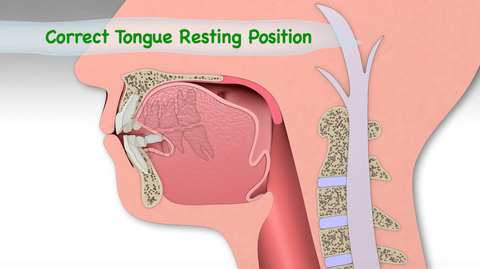Why Mewing Changes Everything
Did you know your tongue plays a critical role in your breathing, posture, and overall health?
Beyond helping you talk and eat, proper tongue posture supports nasal breathing, improves spinal alignment, and prevents forward head posture, making it a key factor in your physical well-being and mewing success.
Mewing Is Hard to Maintain—There's an Easier Way
Keeping your tongue pressed against your palate 24/7 is nearly impossible. The moment you forget, you lose progress. Your tongue drops, your jaw relaxes, and months of mewing effort fade.
The Functional Activator maintains optimal tongue posture passively—even while you sleep. No conscious effort required.
Mewing AlternativeContinue reading to learn proper mewing technique, then discover how to automate your results.
In this comprehensive guide, we'll explore the science behind tongue posture, its connection to your health, and proven techniques you can use to achieve better breathing, improved jawline definition, and enhanced facial structure through proper mewing technique.
What Is Proper Tongue Posture for Mewing?
The Correct Mewing Position
Proper tongue posture is the foundation of effective mewing technique. This refers to where your tongue naturally rests when your mouth is closed and forms the basis for facial restructuring. Here's the optimal position for mewing success:
- The tongue's tip rests lightly against the roof of the mouth, just behind the front teeth (not touching them)
- The middle and back of the tongue gently press against the entire palate
- Lips remain sealed while breathing through your nose
- Teeth are slightly apart without clenching your jaw
This position is essential for optimal breathing, swallowing, and speaking while preventing strain on the jaw, neck, and shoulders. Consistent practice of this position is what makes mewing work effectively for jawline enhancement and facial development.

Signs of Incorrect Tongue Posture That Hinder Mewing Results
If your tongue rests at the bottom of your mouth or presses against your teeth, it can severely impact your mewing progress and lead to:
- Mouth breathing, reducing oxygen intake and preventing proper facial development
- Forward head posture, leading to neck tension and poor spinal alignment
- Dental crowding or malocclusion, which affects your bite and jaw alignment
- Snoring or disrupted sleep, linked to airway blockage and poor breathing patterns
- Slower mewing results, as improper tongue position prevents effective facial restructuring

How Proper Tongue Posture Enhances Mewing Results
Mewing and Nasal Breathing Connection
When your tongue is positioned correctly for mewing, it naturally supports nasal breathing, which is crucial for facial development. Nasal breathing during mewing improves oxygenation, calms the nervous system, and supports the structural changes that make mewing effective. Mouth breathing severely hinders mewing progress by preventing proper tongue posture and reducing the facial muscle engagement needed for jawline enhancement.
Mewing's Impact on Facial Structure and Posture
Your tongue connects to muscles throughout your jaw, neck, and shoulders. Proper mewing technique creates a chain reaction of improvements: correct tongue posture stabilizes the jaw, enhances facial symmetry, improves head positioning, and reduces strain on your upper back.
The Functional Activator ($279) is specifically designed to maintain optimal tongue posture for mewing, ensuring consistent progress even while you sleep. This medical-grade device addresses the biggest challenge in mewing: maintaining perfect form 24/7.
Proven Benefits of Proper Tongue Posture for Mewing
1. Enhanced Facial Development and Jawline Definition
Proper tongue posture is the foundation of effective mewing. It promotes natural facial restructuring, enhances jawline definition, and supports better facial symmetry over time.
2. Improved Breathing and Oxygen Intake
Correct tongue positioning encourages nasal breathing, which improves oxygen intake, promotes better sleep quality, and supports your overall energy levels.
3. Better Postural Alignment Throughout the Body
By positioning your tongue correctly, you can alleviate forward head posture, uneven shoulders, and upper back tension while supporting spinal alignment.
4. Enhanced Oral Health and Dental Alignment
Correct tongue posture prevents teeth grinding, reduces malocclusion, promotes healthy dental spacing, and supports natural oral health.
5. Natural Stress Relief and Better Sleep
Nasal breathing supported by proper tongue posture activates the parasympathetic nervous system, helping reduce anxiety, improve sleep quality, and eliminate snoring.
Test Your Current Tongue Position
The Swallow Test
Here's how to check if your tongue posture is correct for mewing:
- Take a small sip of water
- Pay attention to where your tongue naturally goes when you swallow
- Your tongue should press firmly against your palate during the swallow
- This is the position you want to maintain for mewing
The "N" Sound Test
Another way to find proper mewing position:
- Say the letter "N" slowly
- Notice where your tongue touches the roof of your mouth
- This is approximately where your tongue tip should rest
- Now flatten the rest of your tongue against the palate
Advanced Mewing Techniques for Faster Results
Important: These mewing techniques require constant conscious effort and take months to see results. Most people struggle to maintain proper tongue posture consistently throughout the day and night. The Functional Activator solves this by passively maintaining optimal tongue position 24/7, accelerating your mewing results without the daily struggle.
1. Progressive Tongue Strengthening for Mewing
- Place the tip of your tongue on the roof of your mouth behind your front teeth
- Gradually press the entire tongue flat against the palate, engaging the back third
- Hold for 10-15 seconds while maintaining nasal breathing
- Repeat 10-15 times daily to build tongue muscle memory
2. Perfected Mewing Technique
The key to successful mewing is consistency and proper form:
- Keep your entire tongue pressed against the roof of your mouth (not just the tip)
- Ensure your teeth are slightly apart without clenching your jaw
- Maintain nasal breathing at all times - this is crucial for mewing success
- Practice throughout the day until it becomes your natural resting position
3. Breathing Optimization for Enhanced Mewing
Incorporate specialized breathwork exercises like diaphragmatic breathing to reinforce the connection between proper tongue posture and nasal breathing, maximizing your mewing results.
4. Supporting Muscle Groups for Better Mewing
Address tight neck and jaw muscles that can hinder proper tongue positioning. Gentle stretching, massage, and posture correction exercises support more effective mewing practice.
Frequently Asked Questions
Does mewing work for mouth breathers who want facial development?
Yes! Mewing can transform mouth breathers by promoting proper tongue posture and encouraging nasal breathing. By training the tongue to rest at the roof of the mouth, mewing strengthens facial and jaw muscles, supports proper breathing mechanics, and gradually reduces reliance on mouth breathing while enhancing facial structure.
Can I breathe properly while maintaining mewing position?
Absolutely! Proper mewing requires nasal breathing while keeping your tongue pressed against the roof of your mouth. Nasal breathing is essential for mewing success, as it optimizes oxygen intake and supports the facial development that makes mewing effective. If you struggle with nasal breathing, practice the breathing exercises in this guide and be patient—it takes time to retrain these patterns.
How long should I practice mewing daily for best results?
Mewing should become your natural resting position rather than a timed exercise. The goal is to maintain proper tongue posture throughout the day and while sleeping for maximum facial development. Consistency is key to seeing long-term mewing results. The Functional Activator helps by maintaining optimal tongue position 24/7, ensuring you never lose progress.
When is it too late to start mewing for facial improvement?
It's never too late to start mewing! While younger individuals may see faster results, adults can still benefit significantly from improving tongue posture, nasal breathing, and facial alignment. Mewing combined with proper breathing techniques can improve overall facial structure and posture at any age.
How does the Functional Activator enhance mewing results?
The Functional Activator is designed specifically to support mewing practice by maintaining optimal tongue posture even while you sleep. Unlike trying to remember proper tongue positioning throughout the day, this device ensures consistent mewing form, promotes nasal breathing, and accelerates the facial development benefits that make mewing effective. It's like having a 24/7 mewing coach that ensures you're always in the correct position.
Transform Your Mewing Results
The Reality of Mewing Success
Manual mewing requires years of conscious effort with inconsistent results because you can't maintain perfect tongue posture 24/7. Most people quit within weeks.
The Functional Activator provides the same benefits passively by maintaining optimal tongue position around the clock—even while you sleep. It's the difference between hoping for results and guaranteeing them.
Every day you wait is another day of incorrect tongue posture undoing years of potential mewing progress. Start accelerating your results today.
Remember that consistency is key to seeing long-term mewing results. Start with proper positioning and gradually build the habit until it becomes your natural resting posture. For those serious about maximizing their mewing potential, the Functional Activator ensures you maintain perfect form 24/7, dramatically accelerating your results.
Related guides to enhance your mewing journey:
References:
- Mew, J. R. (2004). The postural basis of malocclusion: a philosophical overview. American Journal of Orthodontics and Dentofacial Orthopedics, 126(6), 729-738.
- Kahn, S., & Ehrlich, P. (2018). Jaws: The Story of a Hidden Epidemic. Stanford University Press.
- Harvold, E. P., Tomer, B. S., Vargervik, K., & Chierici, G. (1981). Primate experiments on oral respiration. American Journal of Orthodontics, 79(4), 359-372.
- Solow, B., & Kreiborg, S. (1977). Soft-tissue stretching: a possible control factor in craniofacial morphogenesis. Scandinavian Journal of Dental Research, 85(6), 505-507.
- Valera, F. C., Travitzki, L. V., Mattar, S. E., et al. (2003). Muscular, functional and orthodontic changes in pre school children with enlarged adenoids and tonsils. International Journal of Pediatric Otorhinolaryngology, 67(7), 761-770.




